Japanese beetles are extremely destructive pests, and they’ve become a major problem for many gardeners.
If you live in an area where they’re present, you know first hand just how quickly they can devour your flowers and plants. It’s very disheartening!
In this post, I’ll show you tons of organic methods you can use to control Japanese beetles in your yard and garden. You’ll learn everything you need to know about them, including their life cycle, what they eat, the damage they cause, and much more.
I remember the first time I saw a Japanese beetle in my garden (it was waaay back in 2008-ish). I actually thought it was kinda pretty (I know, crazy right!?!).
But over the course of 2-3 years, the population exploded, and they quickly became a HUGE pest here in Minnesota.
Now I see hundreds of them in my garden every summer. Hundreds! They are completely out of control.
If you don’t have these invasive bugs in your region of the world yet, you’re lucky. Fighting Japanese beetles can be extremely frustrating, and it’s pretty much impossible to get rid of them completely.
But it’s not all gloom and doom. There are tons of methods you can use to control them and prevent major damage to your plants.
What Are Japanese Beetles?
Japanese beetles (JBs) are extremely destructive scarab insects that were introduced into the eastern United States in the early 1900’s.
They are native to Japan (hence the name), where they are not considered a pest. But, they’re an invasive species here in the US.
Over the last century, they have become a widespread problem in many states – especially in the eastern and midwestern US, and areas of southeast Canada. But they are slowly making their way to the western parts of North America, so be prepared.
What Do They Look Like?
Adult Japanese beetles are oval-shaped iridescent bugs. They have a bronze-colored body and a green head, with fine white hairs on their undersides.
There are five white tufts of hair along both sides of their body, which look like dots from the top, or lines from the side.
The adults are usually about 1/2 inch long, but can be smaller. They can fly, and are very active during the day.
In their larval stage, JBs are C shaped white grub worms that live underground. They are about a 1/2 inch long or so, and have a white/cream colored body with a tan/orange head.
The grubs also have six creepy looking legs on the top of their body, and a green-brown colored tail end.

Life Cycle
There are four stages to the Japanese beetle life cycle: egg, larvae (aka: grubs), pupa, and adult. Interestingly enough, they spend most of their life underground, which is partly what makes them so difficult to control.
The adults only live for about 6-8 weeks, thank goodness. But they can do a LOT of damage in that short amount of time, as many of us know from experience.
Female beetles lay eggs in the soil throughout the summer, where the larvae hatches a couple weeks later. The grubs feed and grow until the soil begins to cool in the fall. Then they go deeper into the ground, where they hibernate for the winter.
In the spring, the grubs slowly make their way back to the surface, where they feed on the roots of grasses and other plants until they’re large enough to pupate.
It takes a few weeks for them to pupate, and then they emerge from the ground as adult Japanese beetles to start feeding on our gardens.
The adults start emerging in late June or early July here in Minnesota. But it could be earlier or later depending on where you live.
At least we have one thing to be thankful for… there is only one generation of JBs per year. Whew!
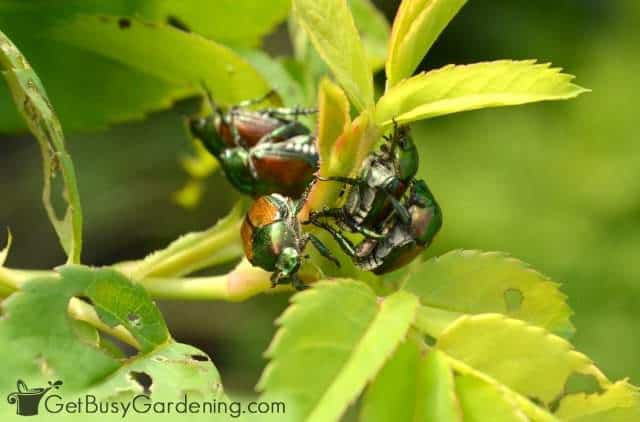
What Do Japanese Beetles Eat?
Unfortunately, they feed on tons of different types of plants and trees, which is what makes them such a major pest. But they do favor some over others.
This extremely destructive pest does double damage. Not only are the adults a huge problem, but the larvae can be too. Japanese beetle grubs feed on the roots of your lawn and other plants, which can damage or ultimately kill them.
Though they can eat pretty much any type of plant, here’s a list of the ones they love the best in my garden. There may be others on your list, depending on where you live…
- roses
- hibiscus
- zinnias
- canna lilies
- grapevines
- beans
- linden tree (they also love fruit trees like apple and peach.)
- coneflowers
- basil
- hollyhock
- raspberries

Damage To Plants
Japanese beetles damage plants by eating holes in the flowers and leaves. They can skeletonize the foliage, and destroy the flowers very quickly. A large population can decimate a small plant in a short time.
The good news is that they mainly feed on leaves and flowers, and they very rarely kill a plant. As ugly as it is, mature plants and trees can usually withstand fairly heavy damage without any long-term effects.
Grub damage isn’t usually as severe or noticeable as what the adults cause. They mostly feed on the roots of grasses, which can cause areas of your lawn to turn brown and die.
However, moles, opossums, skunks, and other animals love eating grub worms, and will dig them up to feast. And that can cause much worse damage to your lawn than the grubs do.
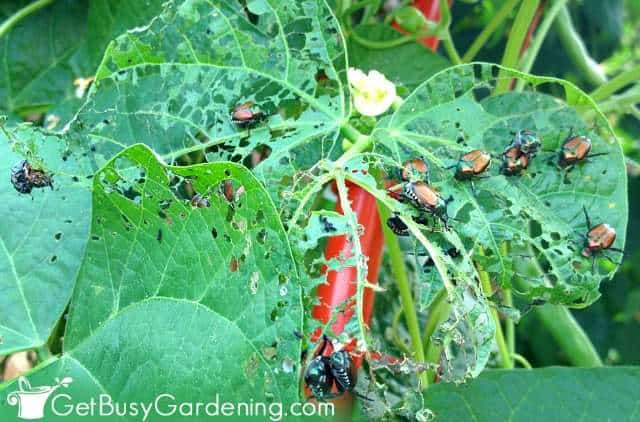
How To Control Japanese Beetles
Unfortunately, getting rid of Japanese beetles completely isn’t a realistic goal. They can fly a very long distance. So, if you live in an area where they’re present, it’s pretty much impossible to eliminate them from your garden.
But you can greatly reduce the amount of damage they cause to your plants. The key to controlling a large outbreak is to get on top of the problem right away. Once they start feeding, they will attract more beetles. So the sooner you get to work, the better.
But before you plan your counter-attack, please try to remember that the adults usually only cause cosmetic damage to plants, and rarely kill them.
So, there is no reason to reach for toxic chemical insecticides, or do any type of broad pesticide sprays or applications to get rid of the JBs in your garden. It’s best to use targeted natural and organic treatment methods instead.
Related Post: How To Control Garden Pests Naturally
Organic Japanese Beetle Treatment Methods
There are several safe and effective ways to control Japanese beetles in your garden organically. Below I’ve listed the ones that I use and recommend. For the best results, you should try all of these methods and see which ones you prefer.
Hand Picking
The fastest way to get rid of Japanese beetles is to remove them from the plants. Simply hand pick them off, and drop them into a bucket of soapy water to kill them. Gross, I know! But don’t worry, you’ll get used to it. Here are my tips and tricks to make this as easy as possible:
- The best time to hand pick them is early in the morning, or in the evening. They aren’t as active during these times of the day. I don’t know about you, but I can’t stand doing it during the day when they’re buzzing around and flying at me – EEK!
- Hand picking the Japanese beetles sounds easier than it is because sometimes they hold on tight to the plant and won’t let go.
- The beetles can quickly drop off the plant as soon as you disturb it, so you have to be fast with the bucket. And don’t stand directly under them either… trust me on this one (that’s a story for another day).
- Don’t just use water in your bucket, make sure to put soap in there too. The soap will kill JBs quickly. Otherwise, they can swim for a really, really long time – like days. Seriously, it’s creepy! And disgusting.
- I’ve tried a few different types of soaps in my bucket, but I like Dr. Bronner’s organic liquid soap the best. It kills the beetles faster than other soaps I have used, which means there’s no way any of them will escape my bucket.
- It takes some work, but hand picking them is pretty easy once you get the hang of it. Plus, it’s definitely satisfying to see all those nasty things floating in the bucket at the end of the day.
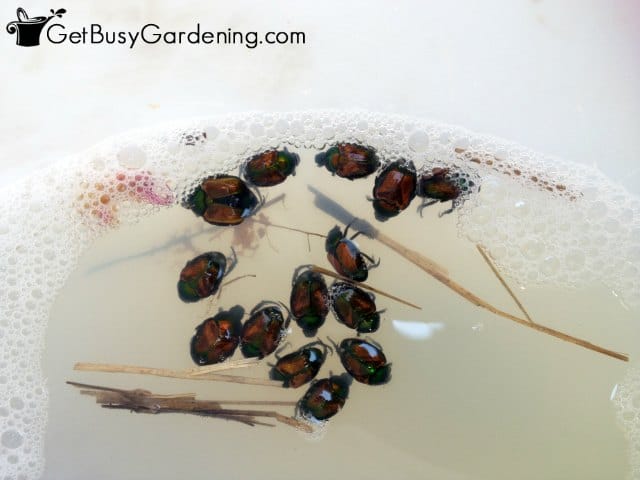
Diatomaceous Earth
You can try sprinkling Japanese beetles with diatomaceous earth (DE) to kill them. This is an all-natural powder that gets under the beetle’s shells as they move around, which cuts them up and eventually kills them (sounds bad I know, but it’s way better than using chemicals).
DE will be most effective when you apply it directly on the beetles, rather than just spreading it everywhere. You could also try using eggshell powder in a similar way.
Insecticidal Soap
Insecticidal soap is another great way to control Japanese beetles. It will kill some of them on contact, and the rest will be stunned and easier to hand pick.
You can buy a pre-mixed organic one, or make your own by combining one teaspoon of mild liquid soap with one liter of water. They don’t have any type of residual effect though, so you have to spray them directly on the bugs.
Beneficial Nematodes
Beneficial nematodes are a natural way of controlling JB grub worms in the soil. They are tiny organisms that feed on the larva, and kill them before they can emerge as adults.
For best results, apply them in the fall and/or spring when the grubs are closest to the surface of the soil. Learn how to use beneficial nematodes here.
Milky Spores
Harmless to beneficial bugs, milky spore is a naturally occurring bacteria that infects the grubs when they eat it, and eventually kills them.
The downfall is that it can take 2-3 years for this method to be effective. But once active, milky spores last in the soil for several years.
Get more natural garden pest control remedies & recipes here.
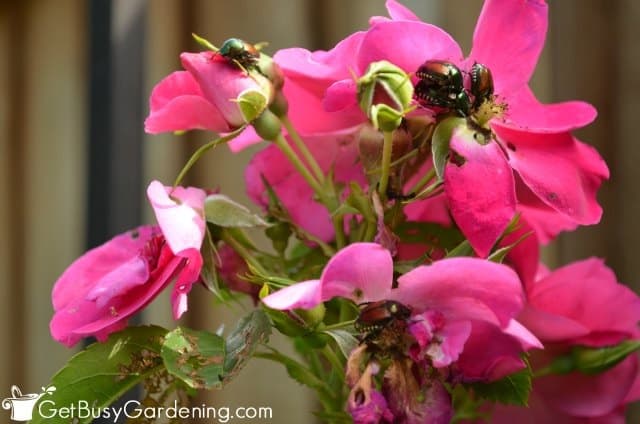
Pheromone Traps
Another great option for controlling Japanese beetles without spraying chemical pesticides is using pheromone traps. They are completely non-toxic and harmless to other bugs.
They work by attracting the adults with pheromones and other scents they can’t resist. The beetles fly into the trap, but they can’t get back out. Read more about how to use Japanese beetle traps here.
How To Prevent Japanese Beetles
One of the easiest ways to control JBs is to prevent them from getting out of hand in the first place. Below are a few methods you could try to prevent them from damaging your plants…
Protect Your Plants
Try covering your prized plants and flowers to keep them from being destroyed. This works great for plants that don’t need to be pollinated by bees.
Use row covers, inexpensive tulle fabric, or garden fabric to keep Japanese beetles off your plants. Just be sure to secure it around the bottom, otherwise the beetles will find their way in. I use clothes pins to hold my fabric in place, and secure the bottoms.
Try Repellent Plants
There are a few plants that could work to repel JBs, including tansy, rue, and garlic. So try interplanting them with the ones that the beetles love the best, and see if they help to deter them.
Grow Plants They Won’t Eat
Like I mentioned above, there are plants that they tend to favor over others. So, if you’re tired of fighting to get rid of Japanese beetles in your garden, then try planting stuff they don’t like instead.
Below is a list to get you started. There are probably many more that you can add to this list, depending on where you live.
- arborvitae
- clematis
- lilac
- ash trees
- chrysanthemum
- maple trees
- burning bush
- boxwood
- dogwood
- daylilies
- oak trees
- rhododendron
- iris
- sedums
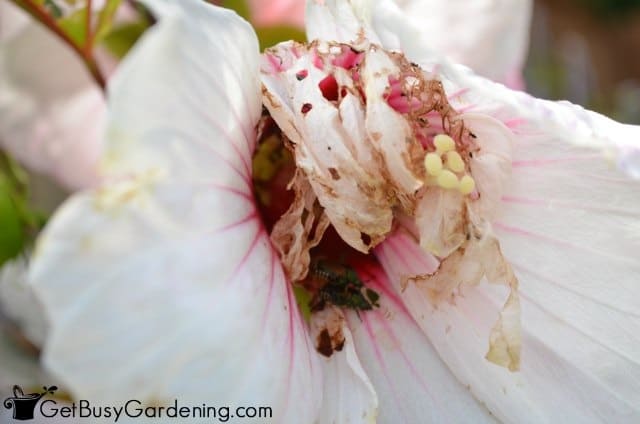
FAQs
Adult Japanese beetles only live for about 6-8 weeks. But the grubs live underground for the rest of the year (or about 10 months).
Bacillus thuringiensis (BT) works best to kill caterpillars and worms that feed on plants above ground. Though it may work on Japanese beetles too, the methods I have listed above are much more effective.
Ehem… They sit on each other because they are mating. Yep, doing it right out in the open. They have no shame.
Yes, JBs can float and swim for a very long time. So when hand-picking, it’s a good idea to add some liquid soap to the water, which will kill them very quickly.
Many types of birds feed on the beetles, including chickens. There are also some types of parasitic wasps, beneficial nematodes, and predatory insects that feed on either the grubs or adult beetles. Skunks, moles/voles, and opossums also love eating the grubs, though they can tear up your lawn and garden digging for them.
The adult beetles are most active during the middle of the day, especially when it’s hot and sunny. They usually start feeding in the late morning, after the dew has dried, and the temperature has warmed up.
No, thankfully. Both the larvae and the adult beetles are harmless to humans and pets, and they do not bite or sting.
Dealing with Japanese beetles in your garden can be very frustrating. But with so many organic options, there’s no reason to use chemical pesticides. Just remember, you’re not going to be able to get rid of them all together. So make controlling them your goal, and you’ll be much less stressed out.
Leave a comment below and tell us how you control Japanese beetles in your garden organically.

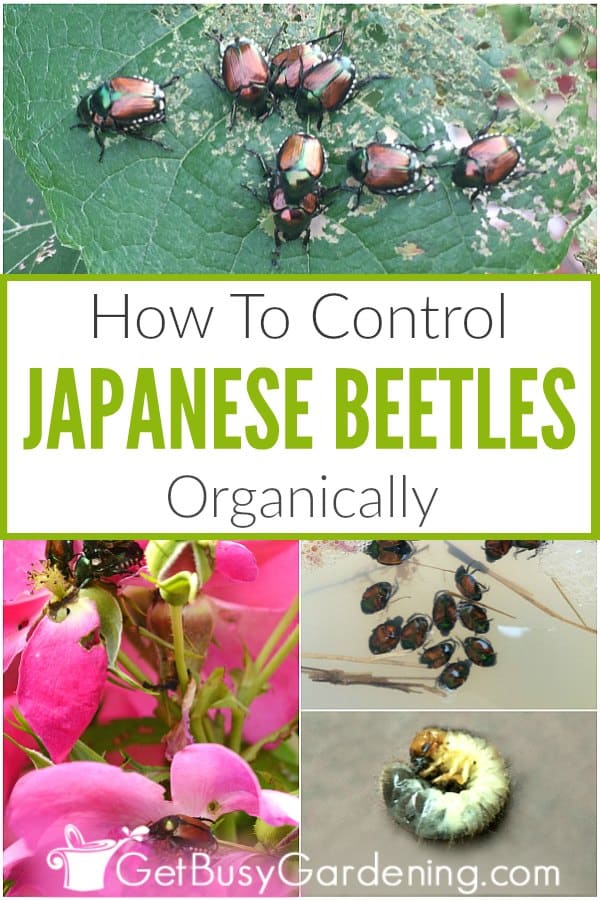
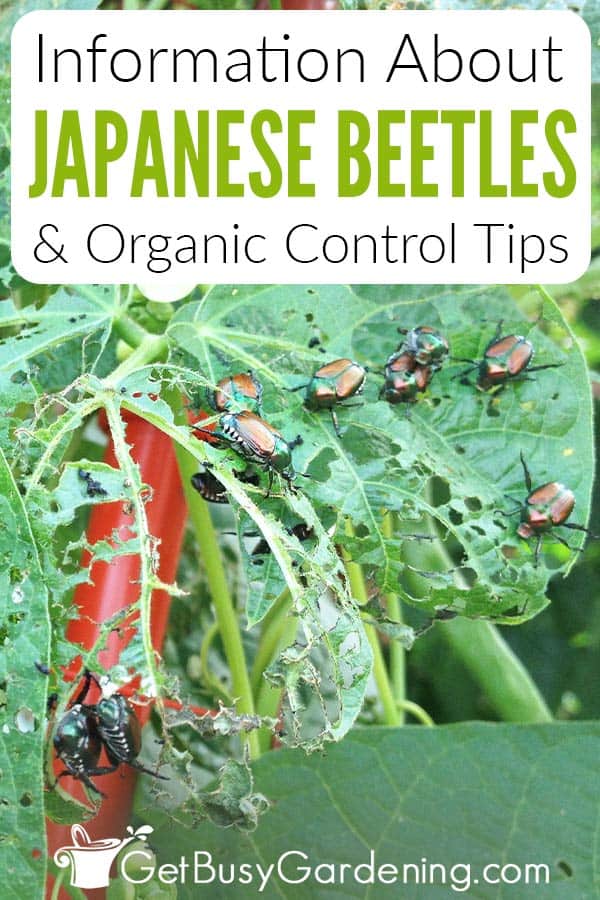
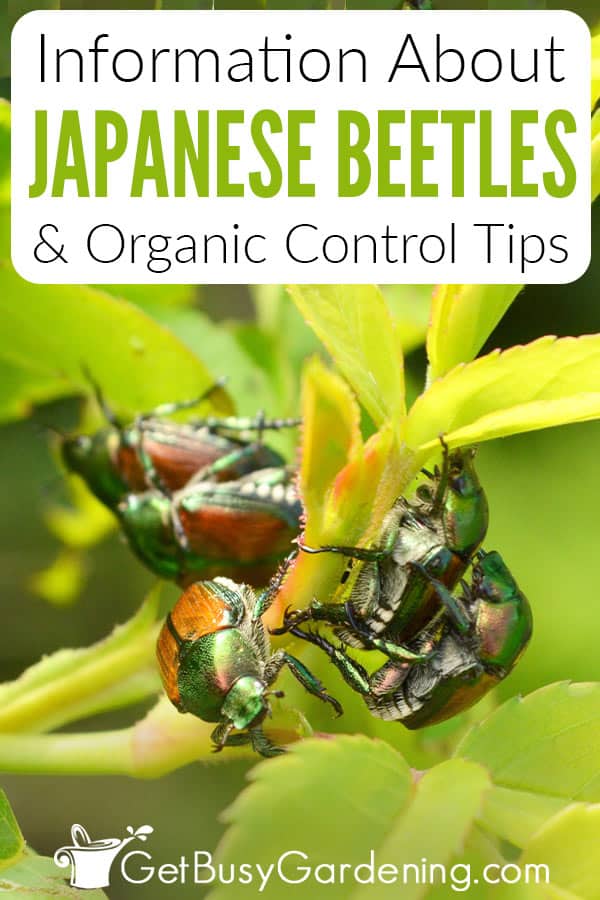
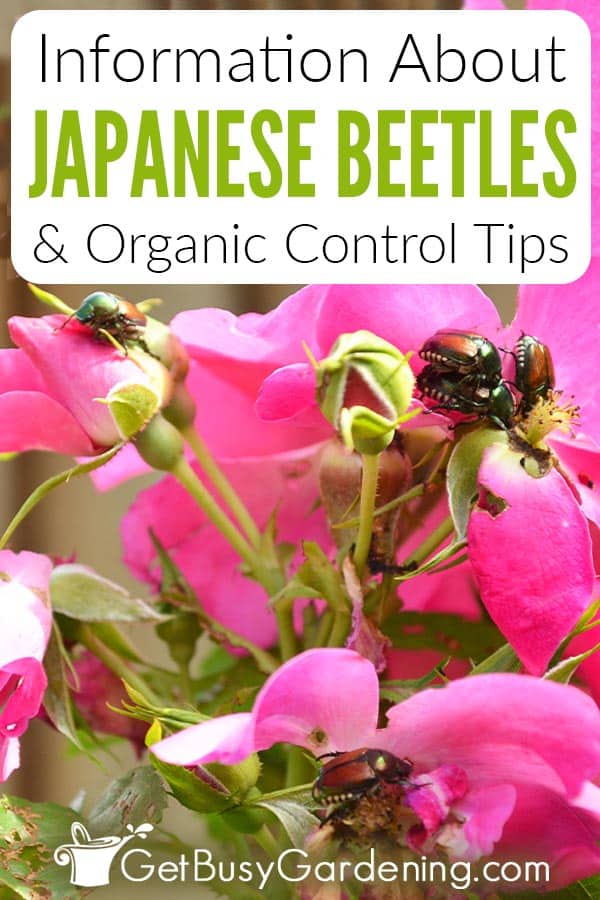
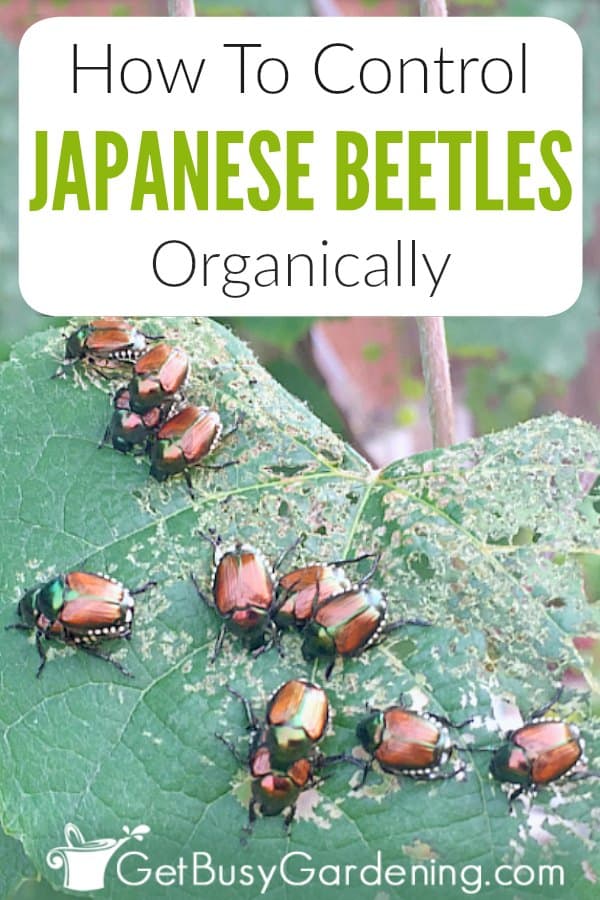
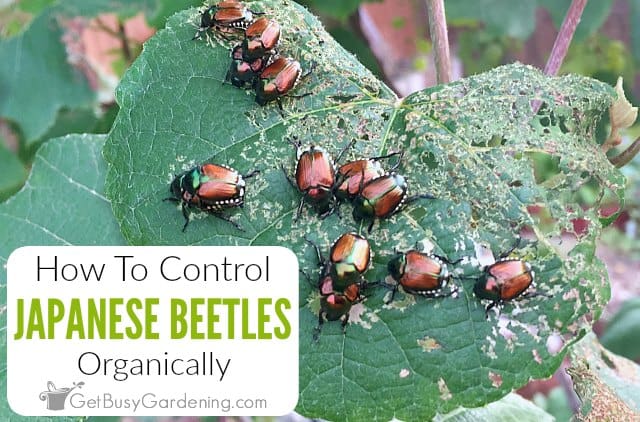


Lola says
I live in mid-Michigan. I’ve been dealing with these beetles for a few years now. I fill a Solo cup about 1/4 full of vinegar, hold the cup beneath the beetle and tap on the flower or twig and let them fall into the cup. They have a tendency to fall anyways and this way I don’t have to touch them. It IS very satisfying to see them floating around in there. My kids are less than thrilled to see my catch. I used the same cup (with the “beetle soup” for a few weeks, then dump it out.
Amy Andrychowicz says
No doubt hand picking them is a gross job. But yes, it’s very easy when the Japanese beetles are slow in the mornings and evenings, and they just fall into the soapy water without having to touch them, LOL!
Tiffany says
I used the picking off method some. I call my chickens as i knocked them to the ground. They love them. In the fall and spring, I turn my soil in the garden and let the chickens in to eat the grubs. I have quite a few moles. I’m sure they help out. This year, I haven’t had a problem with them thank goodness.
Amy Andrychowicz says
Wow, that is so awesome. Every time someone tell me how much chickens love to eat Japanese beetles, it makes me want to get some! LOL. I’m thrilled to hear the JBs aren’t a problem for you this year, sounds like the chickens are working! Yay!
Darlene says
I live north of Denver, Colorado. I first discovered them here a year ago after they had decimated nearly all the leaves on my grape vine. Later I fount out they had practically destroyed the grape vines on the western slope. What I did then was to just pick them off by hand. Thankfully I don’t have a fear of most insects. So I started looking for them this spring. Hello, beetles, and started picking them off by hand. I’ve done considerable research, the Denver TV station gardeners have been talking about them. Almost everywhere I’ve read it has been suggested to spray your lawn with soapy water. You don’t mention that here. Also to dig up a foot-square of lawn about four inches deep to see if you have grubs.. Digging revealed nothing, but I do spray. What a chore when you have a bigger lawn. Also I’ve read and heard that using Japanese beetle traps can make things worse. It uses a pheromone that attracts beetles and since they do fly, and can up to five miles at a time, you’re going to end up attracting all the beetles in the neighborhood. I have now discovered the beasties eating on my mallow, nothing on the hollyhocks yet. I have found a few on the raspberries. Another product that has been mentioned on the TV spots is Grubbegon and Beetlebegon. These are supposed to be fully organic. Is the lawn the only place where the beetles will lay their eggs? I do have an area that seems to die off, but that’s been every year, especially when we are in drought conditions. Anyway, I just wanted to share and ask a question or two. Thank you for your site.
Amy Andrychowicz says
Yes, Japanese beetles are the worst! They started out on the east coast, and are slowly making their west. I read that they just hit the Rocky Mountains a few years ago, and a few states on the west coast are just starting to report seeing them. Booo!! 🙁 I have never heard of spraying the lawn with soapy water before, but I don’t like the idea. Soapy water can kill ALL types of bugs, including the beneficial ones. So, it’s best to use control methods that only target pest insects. As for the traps, I have heard the same claims. I have used them, and personally didn’t notice an increase in the amount of JBs in my yard. Plus it is very satisfying to capture them, knowing that you’re getting rid of some of the population. Here’s a post I wrote that’s all about using the traps, including pros and cons… How To Use Japanese Beetle Traps. Just remember that the grubs are only at the surface of the soil for a short time (right before the adults emerge, and right after the eggs hatch), so you won’t find them by digging once they go deeper into the soil – and grub treatments won’t work unless the grubs are near the surface. Good luck with your fight, sorry you have to deal with them now too!
Darlene says
Thank you for your reply. I got to thinking about the GrubGone and decided that is NOT the way I want to go. Exactly for the same reason you gave. It will kill off grubs of beneficial insects. We have cicadas every year and the adults lay eggs in the ground and the grubs come up mid summer. I’m not about to kill off those grubs. I love listening to cicada song. I had already decided to quit spraying with soapy water. I think we can deal with just about any grub that grows in the ground. I get a ghoulish pleasure of picking off the beetles and dropping them in a bucket of soapy water. If you do that, just remember to dump the bucket every couple of days depending on size of bucket and do it away from your house. A hundred decaying bodies does not smell good and attracts flies. I picked off over three dozen just today. I’m wondering if they are in their second hatching. I’ve read JB will hatch twice in a season. Thanks again for your reply, may we all be successful in staying ahead of these pests.
Amy Andrychowicz says
You’re welcome! Yes, great advice! Same goes for emptying the traps on a regular basis, if you decide to try those. It’s amazing how terrible all those dead beetles can smell after a few days in the hot sun (gag!!). The good news is that there is only one generation of Japanese beetles per season. However, their hatchings can be staggered, so that’s why you’ll see them coming over a few months time, rather than just dying off after one month. 🙁
Barbara says
I couldn’t figure out where to make a comment on the original article. Do NOT USE PHERAMOME TRAPS!!! It’s satisfying to catch large numbers of them, but if you catch 500, then you have attracted 5,000 to the entire neighborhood. They can sense the pheramones from at least half a mile away and will come in droves. Stick to hand picking and throwing into soapy water, diatomaceous earth, neem oil mixed with liquid dish soap to spray on plants, and milky spore to kill larvae. If you have roses, cut the flowers off and either take them inside or throw them out as soon as beetles appear. They will be ready to rebloom around the time the beetles are gone.
Amy Andrychowicz says
Yes, I’ve heard that before about the traps, but definitely have not had that experience after using them for several years. I wrote an entire article about the pros and cons of Japanese beetle traps here, if you’re interested in learning more.
Carol says
I’ve tried everything aside from pesticides (I’m an organic gardener) to get rid of Japanese beetles. I finally read that if you kill them while they’re in their grub stage you can most effectively stop them. So I found this milky spore powder and sprinkled it around the plants in the spring and since then I’ve not really had any issues. This of course took some foresight (last summer’s garden was devastated).
Amy Andrychowicz says
Woohoo! I’m glad to hear that milky spores worked for you against your JB population! I’ve heard that from others too.
CrazyAnn says
I can feed the hand picked ones to my chickens by capturing them in a jar and throwing the jar into the freezer for several hours to paralyze them. Then I throw the beetles out and my chickens just gobble them up like they are M&Ms.
I found that this year, my japanese beetle population was just as bad as last so even with as many as I took out of the general population last year using the traps, it did not matter. And honestly, the damage to my gardens was worse last year because I think they stop on the way to the traps and feast there first. I thought if I set JB traps all up on the perimeter of my 3 acres, away from the roses, grapes, crepe myrtles, hibiscus, pole beans & many of their other fav foods that I would have less damage. That did not prove out in any way.
So this year we started to evaluate the crops they seem to love the best. We decided to take out many of the crepe myrtle that seem to draw them in. They were planted badly by the previous owner anyway. I won’t give up the roses or grapes but can hand pick from them and feed them right to the chickens. I plant low growing bush beans and save the pole beans for after JB season is over.
Amy Andrychowicz says
I love that your chickens eat them like their M&Ms, LOL! Wish I had some chickens to eat all my Japanese beetles! It’s so discouraging to go out every night and hand pick hundreds of beetles… only to have the same amount the next day, and the next, and the next… ugh! You might have the right idea about just giving up on certain types of plants. We cover our grapevines, and that works great. The roses have a few weeks to look beautiful before the beetles destroy every bud and flower on them. It’s super frustrating!
Paul and Mika Gens says
Hi again from Wabasha. Our house, new to us, is actually from 1880 and we lost many mature shade trees to EAB or age. We didn’t know most of our new trees were the fav’s of the JB’s! After I wrote you last time we sought some advice from the local nursery business and decided to try a bit of everything. So to save our investment in legacy trees,.shrubs and perennials while continuing to provide shade for us and shelter for the birds in our flyway zone we: pick off bugs with surgical gloves & drop them in Dawn soapy water in the mornings. We made food traps in gallon jugs and purchased pheromone JP traps (and they really do work here) and hung them from Shepard’s crooks. The very tall trees, grape and Engleman vines we treated lightly with Bonide Eight using our hose. We did this on the veg as well. The second week of August we will treat the eggs in the soil using a liquid Bonide. So far we finally seem to be ahead of the curve and still have wild bees and Monarchs. I hope this helps others. We love gardening and want it to be safe and healthy for all while protecting our investment as retirees. Thank you for a great web site. I always learn something interesting.
Amy Andrychowicz says
Thanks for sharing your tips for controlling Japanese beetles. Please do be careful with the Bonide spray on your trees, and never use it on trees that are blooming. I can kill the bees and butterflies too. Once your trees grow larger, they’ll be able to handle the beetle damage, and you shouldn’t have to worry as much about it.
You’re welcome, so glad that you enjoy the site, and always learn something! 🙂
Susan says
Do you find the tulle rips easily? I got old curtains at Goodwill that I’m going to try using them as row covers this year–they’re green, so maybe they’ll blend in a little more.
Amy Andrychowicz says
The tulle doesn’t rip as easy as it looks like it would, but it’s still a good idea to be careful with it. The curtains you got sound like a great find!
Random says
We have found tons of japanese beetle on our plum trees and other shrubs. Thanks for the heads up, I knew exactly what to look for and do once I spotted it! Of course, now they are on top of 15ft apple trees, so wondering how to catch it. Do you have any advice for that? Can you spray soapy water on the bugs? Since we have apples on them, also veggie plants below, won’t be using insecticides…
Amy Andrychowicz says
You’re welcome, glad I could help! I’m sorry to hear the Japanese beetles are up so high in your trees. I would definitely try spraying them with soapy water either early in the morning or in the evening when the beetles aren’t as active. It may not kill them right away, but many will drop from the trees, and you can squish them. You could also try shooting them with a strong spray from the hose, again to knock them down so you can squash them. Good luck!
Paul and Mika Gens says
Thanks for a great read! We moved from Minneapolis down river to Wabasha two years ago and have a terrible Japanese beetle problem. In Minneapolis the beetles stayed on our grape vine and touched nothing else (including a little leaf linden) but here are feasting on roses. We have a large inherited rose area that I have planted all around with milk weed for the Monarchs. Lots of Monarchs arrived this year and I was reluctant to try any soap sprays so we bought the pheromone trap and placed it away from the area. It is filling up and the beetles on the roses are less but the damage is done. Next door the above ground gardens had beans that are just decimated and they are trying the food trap idea. We have two at risk newly planted lindens. Thank you for the helpful hints of yours and your readers. Once the beetles are done with, should all the soil in the affected area be dug up and replaced?
Amy Andrychowicz says
You’re welcome! Oh no, I’m sorry to hear the Japanese beetles are so bad in your new home! That’s a huge bummer! Unfortunately, they lay there eggs everywhere, including in the lawn. So, it would be impossible for you to dig up and replace all of the soil, unless you want to dig up your entire yard. 😉 Good idea, but definitely a futile effort.
Rita says
Thanks for the great information. I have a pergola over my deck that is covered with grape plants and the beetles are having a hay day. But I’m so curious. You said “And don’t stand directly under the beetles either… just trust me on this one (that’s a story for another day).” I have to know why not. LOL
Amy Andrychowicz says
LOL! Let’s just say I’ve had a bad experience with lots of Japanese beetles raining down on me when my husband was up on a ladder trying to hand pick them off our grapevine. You can imagine my reaction (it was not pretty!!). Haha! After my initial freak out dance I thought I had gotten them all off, but then I found one crawling on me two hours later! EEK!!!
Dianne says
Can one use Dawn dishwashing detergent and water for the Jap. Beatles?
Amy Andrychowicz says
Yes, you can use any type of liquid soap you want in your bucket when you’re hand picking the beetles. But be careful if you plan to use it to spray Japanese beetles on your plants. Sensitive plants can be damaged by harsh detergents and degreasers.
Kwame Ocansey says
I have no idea why you have JBs in the day time in Minnesota. Here in Connecticut they appear mid July for a month and only wake up after 10:00pm. They don’t need to travel anywhere because they live right in the ball of the plant – about 4 inches into the soil. Picking and smeering them in my large garden is insane. Particularly when mosquitoes are eating me alive. They love my fleshy leaves, best of all every basil, every mint, every stevia and kale, kalaloo – my precious plants all destroyed within a month. Dig into the ball of your crops and you will find them napping there. I REALLY, REALLY, REALLY, REALLY need a way to get rid of them. I have a 20lb bag of diatomaceous food grade, hoping it will help to rid the grubs before they mature into the evil pests they are. Any help?
Amy Andrychowicz says
Humm… it sounds like you may be talking about a different type of beetle? Japanese beetles are active during the day, and dormant at night. They do lay their eggs in the soil, and the larvae live underground until mid-summer. However, the adults don’t hide in the ground during the day and come out at night. I wonder if you have Asiatic beetles? They look similar to Japanese Beetles, but they are more brown, and they usually feed at night.